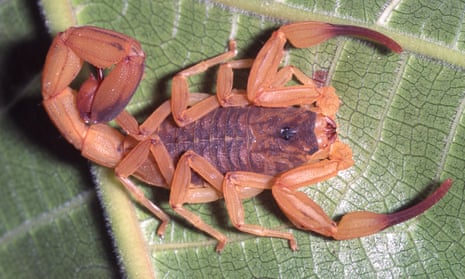Specialists in Brazil have warned of the rising danger of deadly scorpions amid a spiraling number of reported deaths and stings by the hardy arachnids which are proliferating in the country’s urban centres.
The number of deaths from scorpion stings reported to the country’s public health system has more than doubled in the past four years, from 70 in 2013 to 184 in 2017, while cases of scorpion stings rose from 37,000 in 2007 to 126,000 last year.
Meanwhile, the death last week of a four-year old girl in São Paulo state has reinforced concerns that many small towns lack anti-venom to treat stings.
Four dangerous species of scorpion are found in Brazil but the yellow scorpion, or Tityus serrulatus, has proved particularly deadly, having adapted from its traditional savannah habitat to survive in sewers, garbage and rubble in urban areas.
“With deforestation and the increase in urban centres this scorpion is increasing its presence,” said Rogério Bertani, a scientific researcher and scorpion specialist at the Butantan Institute, a São Paulo research institute attached to the state government. “Contact with human beings is very big. I believe personally this will tend to get worse.”
The yellow scorpion is parthenogenetic, which means the female can breed without being fertilised by males and it eats insects such as cockroaches.
“These scorpions have a low metabolism and can live various months without feeding,” Bertani said.
Small children are especially vulnerable. This week Yasmin de Campos, four, died after being stung by a scorpion in Calabria Paulista in the interior of São Paulo state, the Estado de S. Paulo newspaper reported.

She was driven to a hospital in Duartina just 10km away but it had no anti-venom and she was only treated three hours later after being driven another 50km to Bauru – by which time it was too late. A receptionist at the hospital in Duartina said that it had no anti-venom stock.
José Brites Neto, a medical veterinarian, leads a four-man scorpion team in the city of Americana in São Paulo state which has captured nearly 8,000 scorpions this year, using ultra-violet light and hunting at night.
Brites Neto said that the yellow scorpion has spread around sewage networks and rainwater drains because of the abundance of cockroaches. “This species is dominating, colonising and very adaptable,” he said.
A spokeswoman for the Ministry of Health said anti-venom is sent to state health authorities who distribute to towns.
“Deaths by scorpions are most strongly associated with the pediatric age group and poisoning by Tityus Serrulatus,” she said. “Light cases, which don’t need anti-venom, are 87% of cases.”
- This article was amended on 15 July 2018. An earlier version referred to scorpion bites rather than stings. This has been corrected.
